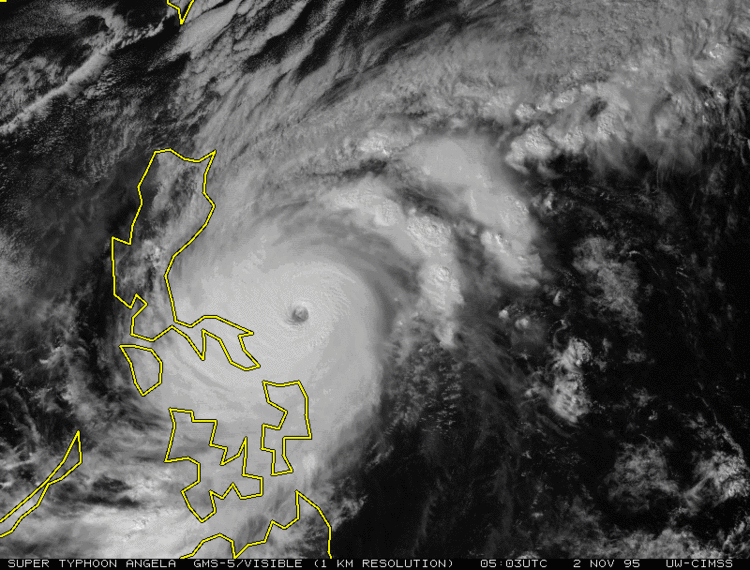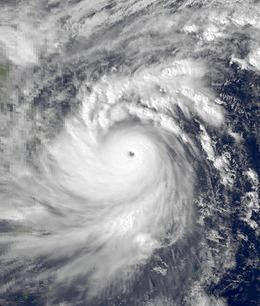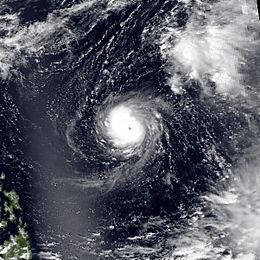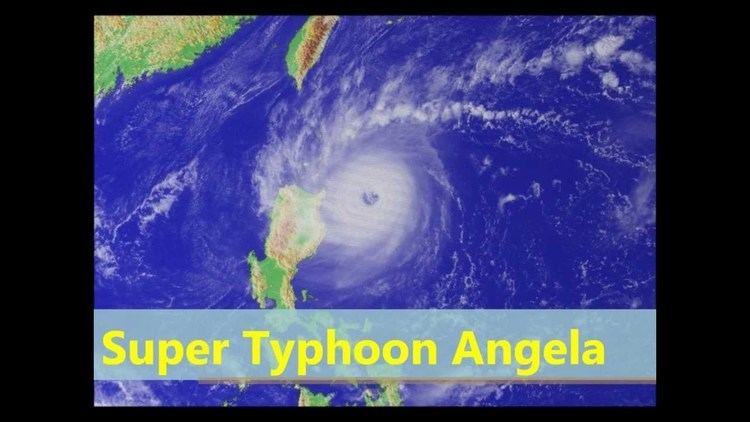Formed October 25, 1995 Fatalities 936 direct | Dissipated November 7, 1995 | |
 | ||
Highest winds 10-minute sustained: 215 km/h (130 mph)1-minute sustained: 285 km/h (180 mph) Date 25 October 1995 – 7 November 1995 Similar Typhoon Angela (1989), Typhoon Ike, Tropical Storm Thelma | ||
Super typhoon angela 1995
Typhoon Angela, known in the Philippines as Typhoon Rosing, was a catastrophic Category 5 typhoon with 180 mph (290 km/h) sustained winds.
Contents
- Super typhoon angela 1995
- Philippines typhoon angela rages through country
- Storm history
- Impact records and retirement
- References

Angela caused 9.33 billion Philippine pesos in catastrophic damage across the Philippines, resulting in 882 fatalities. It was the strongest typhoon to hit the Philippines in 25 years.

Philippines typhoon angela rages through country
Storm history

The monsoon trough that developed also Yvette and Zack spawned another tropical depression on October 25 in conjunction with a tropical disturbance that originated in the Marshall Islands. It moved to the west, organizing very slowly to become a tropical storm on October 26. Two days later Angela became a typhoon, and from the October 31 to November 1 Angela rapidly intensified to a 180 mph (290 km/h) super typhoon, while Japan Meteorological Agency reported that it had reached its peak wind speeds of 130 mph (210 km/h). It maintained that intensity as it moved westward, hitting the Philippines on November 2 as a slightly weaker 160 mph (260 km/h) typhoon. Angela continued to the west-northwest, where upper level winds caused it to dissipate on November 7 over the Gulf of Tonkin.
Impact, records, and retirement
More than 900 people perished due to the catastrophic typhoon. It wreaked havoc over Metro Manila, Calabarzon Region and Bicol Region. Initially it caused 9.33 billion pesos of damage, but later on it grew into 10.829 billion pesos.
Throughout the affected area, more than 96,000 houses were destroyed, along with bridges and roads. The worst impact was in the Southern Bicol Region. Angela passed almost right over Manila, causing a significant impact both there and in Catanduanes. In Calauag, storm surge and flooding from a dam failure killed 121 people. In nearby Paracale, mudslides killed more than a hundred people. Power outages affected one third of the country.
Angela's 872 mbar pressure reading makes it one of the strongest typhoons on record. While this is low by the standards of any sea-level location, it is still behind Typhoon Tip, the most intense tropical cyclone ever recorded. However, Angela is an unofficial contender for world's most intense tropical cyclone. In a study utilizing the Dvorak technique for analysis of post-1987 typhoons, the authors concluded that Angela and 1992's Gay were higher on the scale than Tip. The authors also thought that Angela might have been slightly more intense than Gay, and hence Tip.
Angela was the strongest typhoon to hit the Philippines since 1970's Joan. On a weather observatory on Catanduanes reported winds of 260 km/h (160 mph). This makes it the typhoon with third-highest windspeeds recorded in the Philippines.
